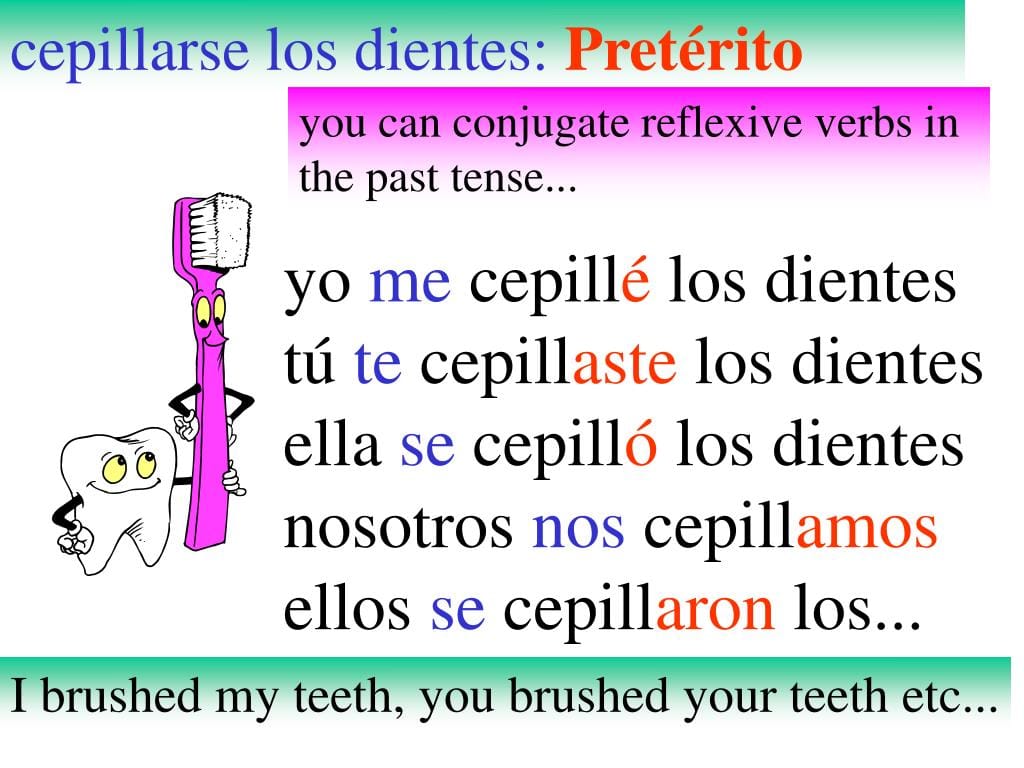This guide will equip you with everything you need to know about the Spanish verb cepillarse, meaning “to brush oneself.” Whether you’re discussing your daily routine or giving grooming advice, using cepillarse correctly will significantly enhance your Spanish communication.
Understanding Cepillarse
Cepillarse is a reflexive verb, essential for describing personal grooming habits in Spanish. It follows regular -ar verb conjugation patterns, but with slight quirks in the infinitive and present tense. This guide will cover all the essentials, from conjugation tables to practical examples, helping you become a cepillarse master. For broader brushing contexts, check out our guide on cocinar conjugation.
Conjugating Cepillarse: A Detailed Look
Cepillarse relies on reflexive pronouns (me, te, se, nos, os, se) which act like a “shadow,” always accompanying the verb. These pronouns indicate that the action of brushing is directed back at the subject.
Here’s a breakdown of cepillarse across common tenses:
| Tense | Conjugation | Example |
|---|---|---|
| Present | Yo me cepillo | Me cepillo los dientes dos veces al día. (I brush my teeth twice a day.) |
| Preterite | Yo me cepillé | Me cepillé el pelo antes de salir. (I brushed my hair before leaving.) |
| Imperfect | Yo me cepillaba | Me cepillaba el pelo cada noche. (I used to brush my hair every night.) |
| Future | Yo me cepillaré | Me cepillaré los dientes después de cenar. (I will brush my teeth after dinner.) |
| Conditional | Yo me cepillaría | Me cepillaría el pelo si tuviera un cepillo. (I would brush my hair if I had a brush.) |
| Present Subjunctive | Yo me cepille | Es importante que me cepille los dientes. ((That) I brush my teeth is important.) |
| Imperfect Subjunctive | Yo me cepillara | Si me cepillara el pelo más a menudo, estaría más suave. (If I brushed my hair more often, it would be softer.) |
| Imperative (Affirmative) | ¡Cepíllate! | ¡Cepíllate los dientes! (Brush your teeth!) |
| Imperative (Negative) | ¡No te cepilles! | ¡No te cepilles el pelo ahora! (Don’t brush your hair now!) |
Reflexive Pronoun Placement
With cepillarse, the reflexive pronoun’s position changes based on the verb form:
- Conjugated Verb: The pronoun precedes the verb (e.g., Me cepillo).
- Infinitive/Gerund: The pronoun attaches to the end (e.g., Voy a cepillarme; Estoy cepillándome). Remember to add an accent mark to the gerund to maintain proper stress.
Cepillarse vs. Cepillar: A Crucial Difference
While similar, cepillarse (to brush oneself) and cepillar (to brush something/someone else) have distinct meanings. Understanding this difference is crucial for accurate communication. The caer preterite offers another example of how seemingly small changes in verbs can greatly impact meaning.
| Verb | Meaning | Example |
|---|---|---|
| Cepillarse | To brush oneself | Me cepillo los dientes. (I brush my teeth.) |
| Cepillar | To brush something/someone else | Le cepillo el pelo a mi perro. (I brush my dog’s hair.) |
Putting it All Together: Practical Application
Reinforce your understanding of cepillarse with these exercises:
-
Translate: Translate sentences like “She brushes her hair every morning” and “They will brush their teeth after lunch” into Spanish.
-
Conjugate: Conjugate cepillarse in different tenses and pronouns.
-
Real-World Scenarios: Describe your daily grooming routine in Spanish using cepillarse.
Cepillar Conjugation: Beyond the Reflexive
Cepillar, the non-reflexive form, means “to brush” something or someone else. It’s a regular -ar verb, making it relatively easy to conjugate.
Present Tense Conjugation of Cepillar
| Pronoun | Conjugation | Example | Translation |
|---|---|---|---|
| Yo | cepillo | Cepillo mi camisa. | I brush my shirt. |
| Tú | cepillas | Cepillas tu cabello con cuidado. | You brush your hair carefully. |
| Él/Ella/Usted | cepilla | Cepilla los zapatos de su padre. | He brushes his father’s shoes. |
| Nosotros | cepillamos | Cepillamos el polvo del mueble. | We brush the dust off the furniture. |
| Vosotros | cepilláis | Cepilláis vuestros abrigos. | You all brush your coats. |
| Ellos/Ellas/Ustedes | cepillan | Cepillan a su perro. | They brush their dog. |
This form is essential when you’re not the one doing the brushing to yourself. For example, you might cepillar your pet’s fur or cepillar a child’s hair. This distinction is crucial, mirroring the similar shift in meaning seen with the caer preterite.
Addressing Common Questions
This section clarifies common doubts about cepillar and cepillarse:
Cepillar or Sepillar?
The correct spelling is cepillar. Sepillar is incorrect. The confusion probably stems from the similar sounds of “c” and “s” in some Spanish dialects.
Conjugation of Cepillarse
As a reflexive verb, cepillarse always includes a reflexive pronoun. This pronoun must agree with the subject of the sentence. Refer to the conjugation table above for a complete overview.
Cepillar in Other Contexts
While primarily used for brushing physical objects, cepillar can sometimes be used metaphorically, such as “brushing up on” a skill. However, this is less frequent than its literal uses.
Delving Deeper: Linguistic Insights
Reflexive verbs, like cepillarse, are a fascinating aspect of Spanish grammar. Some linguists theorize they evolved from non-reflexive forms, with the reflexive pronoun initially serving to emphasize the “self”-directed action. Over time, this usage became grammaticalized, forming the reflexive verbs we use today. This exemplifies the dynamic nature of language, with even small elements like pronouns evolving and shaping how we communicate. For a better understanding of complex verbs, you can explore resources like this.
Conclusion: Mastering Cepillarse
By understanding the distinctions between cepillarse and cepillar, mastering the conjugation, and considering the grammatical nuances, you’ll be well-equipped to use these verbs correctly and confidently. Regular practice and real-world application will solidify your understanding and help you communicate effectively in Spanish.
- Unveiling the Enigma: Mansoureh Khojasteh Bagherzadeh’s Public Appearances & Private Life in Iran - July 18, 2025
- Unveiling the Mystery: Mansoureh Khojasteh Bagherzadeh’s Husband: A Rare Glimpse into a Private Life - July 18, 2025
- Unveiling Masoud Khamenei’s Mother: Power, Influence, and Iran’s Future - July 18, 2025

















1 thought on “Mastering Cepillarse: A Comprehensive Guide to Conjugation and Usage”
Comments are closed.